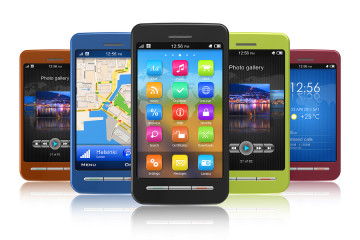Analyzing the Impact of Mobile Phone Technology on Modern Communication in Various Market Segments: A Study of China and the USA

by Solomon Lartey October 10, 2024
- Introduction
Mobile communication technology represents a radical change in communication that has affected nearly all life aspects over the past few decades. Its arrival has changed how people interact at work, with friends, family, strangers, and even public organizations. The younger generation, in particular, is experiencing a revolution in communication. Because of cell phones, people who would not previously speak are now conversing from thousands of kilometers away. Social communication has adapted to contemporary conditions through diversified mobile services such as texting, picture messaging, and e-mailing.
In China, mobile phones are not merely a tool for communication; they have become a necessity. People often forget their keys or wallets, but rarely do they leave their homes without their mobile phones. Life in China without a mobile phone is unimaginable. Once considered a luxury, the ownership of mobile phones is now widespread. In 2007, there were 33.95 million mobile phone subscribers in China, and by July 2014, the number had surged to 979 million. The rapid growth of mobile phones has led to the emergence of new ways of social communication. Instead of phone calls, mobile texting has become the most frequently used communication method.
In the USA, rapid development and broad implementation of mobile technology have significantly impacted communication at various levels, including interpersonal, social, and societal levels. The emergence and rise of different services and products powered by mobile technology have radically altered the flow of communication. For example, reading newspapers or watching television news has been largely replaced by checking daily news through mobile applications, such as Google News. Traditional land-line phone calls have also been replaced by mobile texting, which is perceived as a more rapid, convenient and low-cost way of communication.
- Literature Review
Mobile technologies underpin innovation and economic expansion. Understanding how mobile technology affects communication in varying market segments necessitates a definition of market segment. A market segment identifies a subset of individuals that behaves similarly in terms of unmet needs, desires, preferences, or demands. Multidimensional aspects may qualify citizens as members of a market segment. In particular, demographic, psychographic, behavioral, and geographic characteristics amplify market diversity. Thus, citizens are members of several market segments simultaneously, and segment size varies. Bigger market segments justify specialized marketing initiatives, while smaller or niche segments may be examined efficiently via ‘mass market’ strategies. (Ejemeyovwi & Osabuohien, 2020)
With over 1 billion users, China boasts the largest mobile subscriber base, while the United States, with 232 million mobile subscribers and 75% of the population subscribed, accounts for the second highest subscriber total. Both countries are predominately GSM. Market penetration saturation maintains China and India as the only two major markets registering a growth in mobile communication users. China has trillions of Yuan worth of mobile phone value at stake, or at least 10 billion Yuan within the next 5 years, which will lead to advancement in immediate, innovative mobile devices usable without complex learning processes or training. The technological momentum of mobile phones is driven partly by its users: students, primarily aged 16-25, now account for 18% of total users as of October 2001; business people between the ages of 26-45, primarily white-collar workers, 53%. (Lee, 2020)
McLuhan foresaw that the runaway expansion of the ‘High’ technologies of electric and electronic media would lead to a clash among local, ‘Low’ cultures, tribal societies, so-called ethnic and ‘legacy’ languages and a shift away from ‘hierarchical’ social organizations of society or nations. Technologically impoverished societies or nations would technologically regress and thus would be unable to compete with industrial nations. The USA and China’s recent WTO accession will require reconsideration of McLuhan’s media paradigm; how culturally averse societies/nations encounter the pull of large swaths of homogeneous screening, media ‘clutching’. Subsequent to this clash, following McLuhan, electronic media renders common, everybody-‘consume’ experiences, rendering local differences ‘irrelevant’. The ‘denationalization’ of media largely explains why media flows are deemed to be one-way, to the disadvantage of local, indigenous cultures/nations. (Ruan, 2020)(Chakrabarti, 2024)
- Methodology
The methodology employed in this research paper consists of two main parts, catering to both the literature review of findings and the comparative analysis between mobile phone technology in China and the USA. A thematic approach applies to the literature review, ensuring that the contents are organized according to themes rather than the countries in review, thereby presenting a clearer summary. The comparative analysis is structured in a country-comparative framework, enabling an easier comparison of mobile phone technology evolutions, market segments’ perspectives, and overall communication impacts across the two countries. (Önder & Zengin2022)
The literature review analysis of pre-existing findings focuses on examining the evolution of mobile phone technology from various perspectives. Initially, early findings from emerging markets are reviewed, subsequently presenting later findings from developed markets, countries in transition, and the comparison between two diverse markets in parallel. Conversely, within the scope of market segments, the literature review analysis investigates the big picture of mobile phone technology evolutions as an international new technology. Thereafter, the review narrows down to presenting the perspectives from mass segments in various countries, considering social inequalities, inequalities in the information society, and psychological influences. Finally, the research highlights some discussions of market segment differences to further compensate for the absent mass segment perspective in the previous analyses.
On the other hand, the comparative analysis between China and the USA considers the evolution of the two countries’ mobile phone technology since 1983 and 1989, respectively, followed by understanding the market segments’ perspectives at different socio-cultural stages of modernization. Afterward, the differences of the two mobile phone technologies and the impacts on modern communication in various market segments are focused on, clarifying the impacts by comparing current mobile phone use in market segment cultures.
- Impact of Mobile Phone Technology on Communication in China
With the advent of mobile phones, the way people communicate has radically changed with profound impact on individuals, companies and societies. The objective of this study is to analyze the impact of mobile phone technology on modern communication in various market segments, and to conduct a comparative study of China and the USA. In this age of globalization where the world has become a communication village, communication is paramount for the prosperity of every market segment. The rise of mobile and mobile broadband technologies has enhanced the ability to communicate anytime and anywhere. (Banafaa et al.2023)(Salih et al.2020)
China, an emerging nation, is well known for its four great inventions, and has now become a keen participant in mobile phone technology. Market segments in China include personal communication, interpersonal communication between office workers and business partners, company communication with clients, bulk SMS marketing in the education and enterprise segment, and mass communication by media platforms to the general audience, among others, all of which have been positively affected by mobile phone technology. Text and voice messages in a limited number of words have transformed language habits. A number of new words and phrases such as “jack lan”, “badong”, and “YH” have emerged among the younger generation, which help in shortening message content and saving time. (Nie et al., 2021)
The technological adoption trends in China indicate that the three types of mobile messenger apps, namely, its bundled mobile services, the Socialisation type like wechat, and the All-in-one type all similar to LINE have observed the rapid increase in terms of user amount since they were launched, with the WeChat service provided by Tencent growing fastest in internet and mobile internet and enjoying an outstanding increase among more urban-independent migrant users as well. Mobile phones have witnessed high penetration in China with particular growth in recently developed provinces and cities like Hubei, Xi’an, Beijing, Shanghai, Shenzhen and other relatively smaller cities. The burgeoning mobile phone technology has greatly facilitated communication in various market segments like personal communication, M2M communication, business communication, and mass communication, with a possitive impact on the fields of technology and economy. (Ahmed & Nunes2020)
4.1. Market Segments in China
The China market can be segmented based on consumer income or lifestyle, following the AIDAM model (Attention, Interest, Desire, Action, and Maintain). Different market segments are listed below in accordance with their significant characteristics.
The upper-end market segment covers elite individuals with an annual income of over 100,000 yuan and a market share of 14.2 percent. These individuals usually enjoy outstanding job positions, financial independence, and strong purchasing power. They have a high propensity to spend their income on luxurious items to match their social status. Furthermore, the internet is important in their daily lives. Their main needs include innovation/novelty, quality/luxury, convenience, status symbol, and speed/exclusiveness. (Yuanchun et al., 2024)
The mid-to-upper segment consists of successful people between 28 and 45, with a family and life plan, who unwillingly sacrifice their time with families for work promotion. Their annual income ranges from 40,000 to 100,000 yuan, and their market share is 38 percent. They have the ability to purchase electronic devices and applications, as well as the willingness and demand for innovative products. Their main needs include ease of use, management of time and family, positive implication on social status, and safety.
The mid-market segment encompasses people aged 20 to 28, newly entering society or still in higher education, struggling to find jobs. Most of them have a family with a monthly income of 2,500 to 6,000 yuan. Their interest in electronic devices likely correlates to their lifestyle, personality, and other factors. This group’s market share is over 40 percent, the largest among all segments. Their main needs include price, fashion, entertainment/satisfaction, ease of obtaining, and safety/integrity.
The lower end market segment refers to poorly educated individuals with a monthly family income of below 2,500 yuan and a market share of 7.5 percent. This group has low purchasing power and will only consume according to pressuring reasons such as family or health implications. They care little about luxury products and are often defrauded while attempting to use electronic devices. Their demands encompass safety, need rather than wants, simple operation, service, and price. (Kimura, 2022)
4.2. Technological Adoption Trends
While there exist natural communicative segments based on the difference between the rural-urban divide, social classes, age groups and gender distribution in both societies, thus far little comparative research exists over the impact of mobile phone technology on communication across different market segments. Presented here is a research of such differences in China and the USA to provide one possible perspective on this major and important topic.
In a broader sense, the communicative effect of any technology can be studied over eight aspects: the overall shift of communication patterns from one to another, the emergence of new channels and platforms along the middle, functions of communication taken over and displaced, reconceptualization of privacy, user characters altered along schematic use, the subjective experience of communicative feel transformed, social and individual identity angle moved, and the social power structure reshaped by it. For research purposes, mobile phone technology is narrowed here as SMS and multimedia messaging services (MMS), indistinguishable from the ill effects of the mobile phone technology on communication, accumulation and remediation concerns inclusive. The impacts on the overall change of communication patterns, the emergence of new forms of communication, and the abandonment of certain technologies are then analyzed comparatively (over the five aspects mentioned above) into revealing and insightful case studies. (Wang et al., 2020)(Al-Rahmi et al.2020)
Mobile phone technology is found to have all eight aspects of communicative impact, and chances are, more than others deeply affecting fundamental norms and assumptions in social interaction or relationship, whether we may be aware of it or not. Given such important ramifications and effects, the impact of mobile phone technology on communication deserves serious academic concern.
- Impact of Mobile Phone Technology on Communication in the USA
Mobile phones have carved a significant role in shaping modern communication in the USA, especially over the past decade. The democratization of mobile phone technology has altered the landscape of how people connect, influencing all groups in society. This section examines the core markets segmented by age groups across four relevant demographics: the youth (aged 18 to 29), the emerging middle adult groups (30 to 44), older adults (aged 45 to 64), and senior citizens (65 and over). There is a notable contrast between the two opposite ends of the age spectrum, as the youth segment exhibits a higher proclivity towards technology use and comfort, while older adults are less equipped and less likely to adopt and engage with mobile phone technology. Though not as segmented as other markets, mobile phone communication has influenced the needs of these groups in many ways—primarily through the acceleration of information dissemination, shaping social dynamics and intimacy, and subverting traditional concepts of privacy, solitude, and silence. (Alencar, 2020)
Exploration of mobile technology communication in this region should also focus on its regulatory frameworks: the USA’s market has fewer government regulations on mobile phone communication compared to that in China, such systems are dictated and maintained by companies and service providers. With this, media literacy is less prioritized in educational institutions. Some knowledge regarding precaution measures is mandated by laws, such as the Telecommunications Protection and Consumer, but with little efficacy. The laxity of the USA’s regulatory frameworks has contributed to a society bent on spending immense time and resources on mobile phones, making accessibility and media literacy questionable, particularly for the youth. (Ezeigweneme et al.2024)(Apcho-Ccencho et al.2021)
5.1. Market Segments in the USA
Market Segments are the basis of each country’s Mobile industry as they define the type of customers the mobile companies target and the services offered. By examining Market segments from some biggest T. Mobile operator companies these segments could gather more information, research and market analysis. The mobile communication company researched within this analysis is T. mobile USA which started in 1994 and owned by Deutsche Telekom of Germany. As for China, it is China Mobile limited; China Mobile, a leading mobile telecommunications corporation, was established in 1997 and became listed on both the New York Stock Exchange and the Hong Kong Stock Exchange. It is a great choice for comparison due to the challenges that China Mobile is facing with its expansion to overseas markets. T. Mobile USA segments its services into the following categories: national, regional, and local service. National services by T. Mobile cut across the whole U. S. such as prepaid cards, commercial resale service for business telephones, and other related services. Regional services cut across areas such as New Jersey; New York covering the states of Maryland, New York, New Jersey, Virginia, and some areas of the District Columbia. T. Mobile region covers up to thirty-one metropolitan areas thus installing over 2000 wireless machines for use. (Dolnicar, 2022)
Local service market segment by T. Mobile focuses on multi-line business customers in a narrow range of metropolitan areas. The specific areas of focus under this segment type are south Texas and Atlanta, Georgia segmenting into the following notable services that would build the revenue of the segment. These services types are T. Mobile local exchange services and T. Mobile service connection, billing and collection services.
As for their recent acquired segment by T. Mobile enhancing the companies service revenue, T. Mobile recently acquired Metro Costume; a company with strong regional wireless industry thus giving the company as strong capital to compete evenly with its better market share managed rivals like AT&T and Verizon Wireless. Metro costume as a customer earns T. Mobile as an access to several metro segments of its own.
5.2. Regulatory Frameworks
The USA is one of the largest countries in the world both in geographical area and population. Due to its large geographical area, it has a diverse population distribution. Many states in the USA are technology-advanced, and vast parts of the US have different basic amenities. This, in turn, has led to several factors defining communication and the pattern of communication. Hence, it is also essential to present the country in multiple ways as it contains multiple facets in the context of the mobile phone technology and its impact on the communication. In the USA, aspects such as the inhabitants, infrastructures, literacy, culture, economic background, and language play an important role in communication which also defines the different market segments. (Banerjee & Sowards2022)
Regulatory frameworks in the USA play an important role in defining and controlling different communication mediums. The basic purpose of the communication regulatory body is to ensure adequate competition in communication markets, to rule out or eliminate harmful practices by individuals and organizations, and to satisfy news needs. Hence regulatory frameworks establish rules and manage procedures for the operation of organizations and individuals. In the USA, the Federal Communications Commission (FCC) is tasked with modeling, protecting, and managing the fields of radio, television, telephone, satellite, etc. in the public interest. The FCC was established in 1934 and is an independent branch of the executive department of the government. It consists of 5 members who are appointed for a seven-year term and cannot serve more than one term consecutively. Although there is no specific requirement for the education qualification of the members, they should have some training or practical experience in the technical or engineering field.
- Comparative Analysis of Mobile Phone Technology Impact
A comparative analysis of mobile phone technology impact on modern communication in China and the USA examines similarities, differences, advantages, and challenges in text and voice communication between these two leading economies. In China, text messaging over mobile phones is widely utilized, integrating into internet platforms, service providers, and unifying application structures such as WeChat. The evolution of service provider models, starting from mobile operators to mobile internet, further drives the ingenuity of text messaging. Additionally, text communication can mitigate pressure and embarrassment, effectively compensating for the unreliability of voice communication. However, unintended contextual variation may arise in text messages due to misinterpretation of slang. (Chen et al.2020)
In contrast, the USA exhibits a growing trend of expressive mass voice communication via mobile phones, offering advantages in response time and conveying emotional coloration. The popularity of voice apps like Instagram Direct may result from inherent conversational advantages that text communication cannot match, providing a greater sensation of reality and immediacy. Although the USA used to be the world’s leading texting society, with 467 billion SMS messages sent in 2010, resulting in a texting rate of 135 messages daily per person, text communication is facing challenges from the development of voice communication.
Synchronous voice communication is a spontaneous form of modern communication arising from historical and cultural circumstances and is being embraced by different cultures in unique ways. While China has quickly expanded from a cash-based society to mobile payment without parallel development of credit cards and online banking, in the USA, most people still insist on using text messaging, even text-flavored voice services, like voice messages and voice mails, emphasizing pre-recognition of messages prior to consumption. Such behavioral differences drive the investigation of both direct and latent cultural consequences of eclectic communication modes usage. The impact of mobile phone technology on modern communication systems, embodied by the arrival of diverse mobile applications and the corresponding generational shifts, remains a mixed blessing. The emergence of eclectic communication modes challenges traditional theories of communication information system meta-models, constituting unintended reciprocal creativity as a dynamic communication system of humans and machines. The steady improvement of artificial intelligences comprehending and rendering overmultimedia, overcontextual and overwhelming information brings new challenges to the appropriateness of communication. (He, 2022)(Qu et al., 2022)
- Conclusion and Future Research Directions
Mobile phone technology has arguably been among the most vital developments in contemporary society. Recognizing its adaptability, its expansion into many aspects of customer habits, and the coalescence of societal transitions, an examination of the effects of mobile phone technology on contemporary communication and its ramifications is warranted. The latter includes, despite not being confined to, adaptations in the lifestyle, habits, and perspective of people as influenced by mobile phone devices. A comparative study of the magnitude and variations that the ramifications exhibit based on the cultural, economic, and/or political framework is also warranted.
This essay summarizes the findings from studies in four market segments: the education, workplace, socialization, and communication segments. Moreover, the results of the comparative study of the two largest markets in the mobile global-sphere, China and the USA, are summed. Conclusively, the impacts of mobile phone technologies are acknowledged to be detailed with respect to the character of the segment, and the societal framework of each market segment.
Mobile phone technology has arguably been among the most vital developments in contemporary society. Even in countries currently labeled as “developing countries,” mobile phone technology is recognized and has been adapted. Moreover, because of its remarkable adaptability, global expansion (as recognized through a steady increase in the number of users regardless of their economic or cultural background), and its potential for coalescing societal transitions, an examination of the effects of mobile phone technology on contemporary communication and its ramifications is warranted. The latter includes, but is not confined to, adaptations in the lifestyle, habits (influences, adaptations, and uses), field, domain, perspective, and even norms of people as influenced by mobile phone devices. A comparative study of the magnitude and variations that the ramifications exhibit based on the cultural, economic, and/or political framework is also warranted. The essay discusses the findings of a broader examination of the effects of mobile phone technology on modern communication in various market segments and a comparative study of the two largest markets in the mobile global-sphere, China and the USA. (Takahashi et al., 2020)
References:
Ejemeyovwi, J. O. & Osabuohien, E. S., 2020. Investigating the relevance of mobile technology adoption on inclusive growth in West Africa. Contemporary Social Science. econstor.eu
Lee, N. T., 2020. Navigating the US-China 5G competition. Brookings Institution. brookings.edu
Ruan, H., 2020. Understanding China’s national identity and identifications through mediated popular culture. warwick.ac.uk
Chakrabarti, S., 2024. ‘The Overheated World’: Crisis Politics and Neoliberal Inertia. [HTML]
Önder, M. and Zengin, Ü.N., 2022. A framework for comparative analysis: Public administration across the globe. In The Palgrave Handbook of Comparative Public Administration: Concepts and Cases (pp. 51-76). Singapore: Springer Nature Singapore. academia.edu
Banafaa, M., Shayea, I., Din, J., Azmi, M.H., Alashbi, A., Daradkeh, Y.I. and Alhammadi, A., 2023. 6G mobile communication technology: Requirements, targets, applications, challenges, advantages, and opportunities. Alexandria Engineering Journal, 64, pp.245-274. sciencedirect.com
Salih, A.A., Zeebaree, S.R., Abdulraheem, A.S., Zebari, R.R., Sadeeq, M.A. and Ahmed, O.M., 2020. Evolution of mobile wireless communication to 5G revolution. Technology Reports of Kansai University, 62(5), pp.2139-2151. researchgate.net
Nie, P., Ma, W., & Sousa-Poza, A., 2021. The relationship between smartphone use and subjective well-being in rural China. Electronic Commerce Research. researchgate.net
Ahmed, G. and Nunes, M.B., 2020. Wechat VS. whatsapp: Why China is not a nation of copycats. In 13th IADIS International Conference Information Systems. archive.org
Yuanchun, L., Yang, S., Fei, W., & Guangsu, Z., 2024. Understanding China’s New Common Prosperity. Springer Books. [HTML]
Kimura, M., 2022. Customer segment transition through the customer loyalty program. Asia Pacific journal of marketing and logistics. emerald.com
Wang, B., Liu, Y., & Parker, S. K., 2020. How does the use of information communication technology affect individuals? A work design perspective. Academy of Management Annals. curtin.edu.au
Al-Rahmi, W.M., Alzahrani, A.I., Yahaya, N., Alalwan, N. and Kamin, Y.B., 2020. Digital communication: Information and communication technology (ICT) usage for education sustainability. Sustainability, 12(12), p.5052. mdpi.com
Alencar, A., 2020. Mobile communication and refugees: An analytical review of academic literature. Sociology Compass. wiley.com
Ezeigweneme, C.A., Umoh, A.A., Ilojianya, V.I. and Adegbite, A.O., 2024. Review of telecommunication regulation and policy: comparative analysis USA and Africa. Computer Science & IT Research Journal, 5(1), pp.81-99. fepbl.com
Apcho-Ccencho, L.V., Cuya-Velásquez, B.B., Rodríguez, D.A., de las Mercedes Anderson-Seminario, M., Alvarez-Risco, A., Estrada-Merino, A. and Mlodzianowska, S., 2021. The impact of international price on the technological industry in the United States and China during times of crisis: commercial war and COVID-19. In Advances in business and management forecasting (Vol. 14, pp. 149-160). Emerald Publishing Limited. [HTML]
Dolnicar, S., 2022. Market segmentation for e-tourism. Handbook of e-Tourism. uow.edu.au
Banerjee, P. and Sowards, S.K., 2022. Working across languages/cultures in international and environmental communication fieldwork. Journal of International and Intercultural Communication, 15(1), pp.36-56. [HTML]
Chen, X., Zhou, X., Li, H., Li, J. and Jiang, H., 2020. The value of WeChat application in chronic diseases management in China. Computer Methods and Programs in Biomedicine, 196, p.105710. sciencedirect.com
He, L., 2022. Mobile-Payments in the US and China. mit.edu
Qu, B., Wei, L., & Zhang, Y., 2022. Factors affecting consumer acceptance of electronic cash in China: an empirical study. Financial Innovation. springer.com
Takahashi, K., Muraoka, R., & Otsuka, K., 2020. Technology adoption, impact, and extension in developing countries’ agriculture: A review of the recent literature. Agricultural Economics. [HTML]
Solomon lartey a PhD student at Teeside university, researcher, influencer, business analyst and construction supervisor.







No Comment